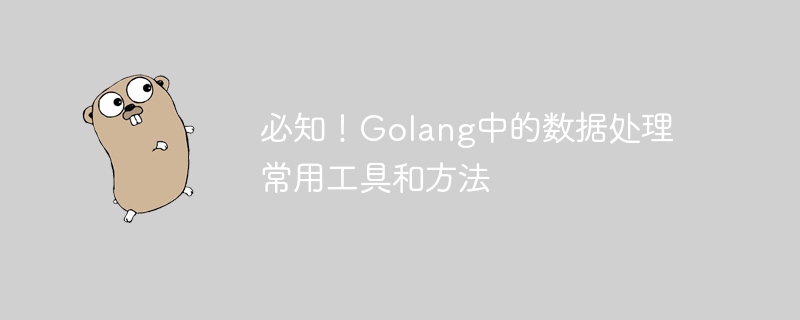Home >Backend Development >Golang >proficient! Master the commonly used data processing tools and methods in Golang
proficient! Master the commonly used data processing tools and methods in Golang
- 王林Original
- 2023-12-23 13:04:11732browse

Must know! Common tools and methods for data processing in Golang
Overview:
In Golang, data processing is one of the common tasks in development. Whether you are reading data from the database, processing user input, parsing JSON data, or performing data conversion, you need to use some common tools and methods. This article will introduce you to several commonly used data processing tools and methods, and provide corresponding code examples.
1. String processing
String processing is one of the most common tasks in data processing. In Golang, there are many built-in functions and methods that can help us complete string processing work. The following are some commonly used string processing methods and their code examples:
- String splicing
String splicing is the operation of concatenating multiple strings into one string. Golang provides a variety of methods for string splicing, including using the " " operator, using the fmt.Sprintf() function, and using the strings.Join() function. The following are their code examples:
package main
import (
"fmt"
"strings"
)
func main() {
str1 := "Hello"
str2 := "World"
// 使用"+"运算符
result1 := str1 + " " + str2
fmt.Println(result1)
// 使用fmt.Sprintf()函数
result2 := fmt.Sprintf("%s %s", str1, str2)
fmt.Println(result2)
// 使用strings.Join()函数
slice := []string{str1, str2}
result3 := strings.Join(slice, " ")
fmt.Println(result3)
}- String splitting
String splitting is the operation of splitting a string into multiple substrings according to the specified delimiter. Golang provides the strings.Split() function to implement string splitting. The following is an example:
package main
import (
"fmt"
"strings"
)
func main() {
str := "Hello,World!"
slice := strings.Split(str, ",")
for _, s := range slice {
fmt.Println(s)
}
}- String replacement
String replacement is to replace a certain sub-string in the string. The operation of replacing a string with another substring. Golang provides the strings.Replace() function to implement string replacement. The following is an example:
package main
import (
"fmt"
"strings"
)
func main() {
str := "Hello,World!"
result := strings.Replace(str, "World", "Golang", -1)
fmt.Println(result)
}2. JSON data processing
In actual development, it is often necessary to work with JSON Working with data. Golang provides built-in encoding/json package to process JSON data. The following are several commonly used JSON data processing methods and their code examples:
- JSON data parsing
JSON data parsing is the process of converting JSON data into Go language structures. Golang provides the json.Unmarshal() function to implement JSON data parsing. The following is an example:
package main
import (
"encoding/json"
"fmt"
)
type Person struct {
Name string `json:"name"`
Age int `json:"age"`
}
func main() {
jsonStr := `{"name":"Alice","age":20}`
var person Person
err := json.Unmarshal([]byte(jsonStr), &person)
if err != nil {
fmt.Println(err)
return
}
fmt.Println(person)
}- JSON data conversion
JSON data conversion is to convert the Go language structure into The process of JSON data. Golang provides the json.Marshal() function to implement JSON data conversion. The following is an example:
package main
import (
"encoding/json"
"fmt"
)
type Person struct {
Name string `json:"name"`
Age int `json:"age"`
}
func main() {
person := Person{
Name: "Alice",
Age: 20,
}
jsonData, err := json.Marshal(person)
if err != nil {
fmt.Println(err)
return
}
fmt.Println(string(jsonData))
}3. Data conversion
In actual development, data types are often required Convert. Golang provides some built-in functions and methods for data type conversion. The following are some commonly used data conversion methods and their code examples:
- String to integer type
String to integer type is the process of converting an integer represented by a string into an integer type. Golang provides strconv.Atoi() function to convert string to integer. The following is an example:
package main
import (
"fmt"
"strconv"
)
func main() {
str := "123"
num, err := strconv.Atoi(str)
if err != nil {
fmt.Println(err)
return
}
fmt.Println(num)
}- Integer to string
Integer to string is to convert The process of converting an integer into a string. Golang provides the strconv.Itoa() function to convert integers to strings. The following is an example:
package main
import (
"fmt"
"strconv"
)
func main() {
num := 123
str := strconv.Itoa(num)
fmt.Println(str)
}The above are some common tools and methods for data processing in Golang, including string processing, JSON data processing and data conversion. By mastering these tools and methods, you can simplify the data processing process and improve development efficiency. Hope this article can be helpful to you!
The above is the detailed content of proficient! Master the commonly used data processing tools and methods in Golang. For more information, please follow other related articles on the PHP Chinese website!

